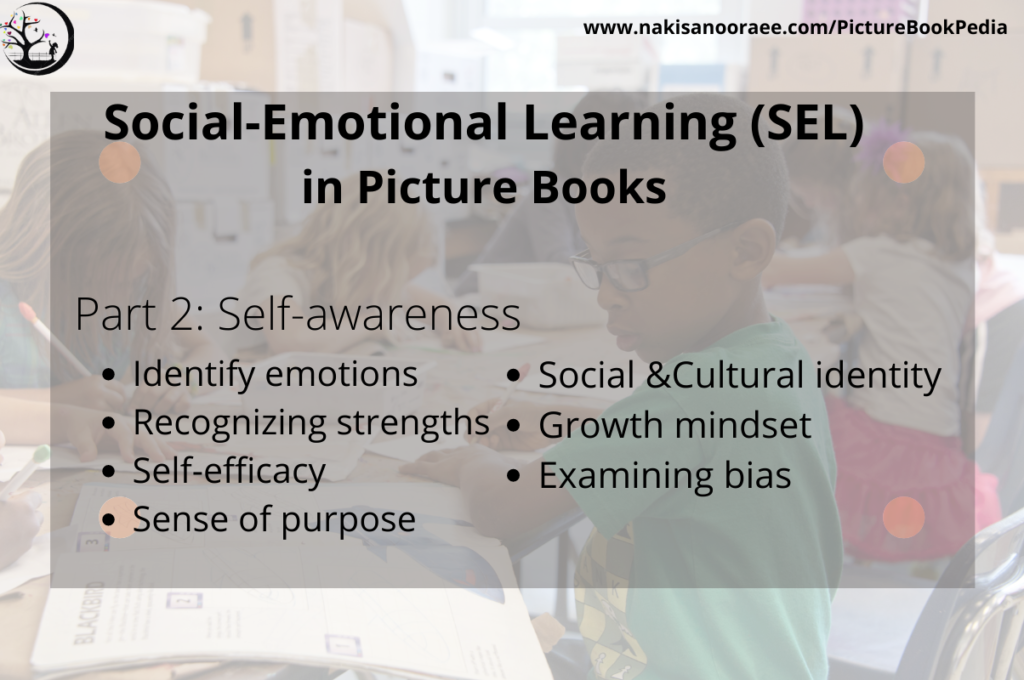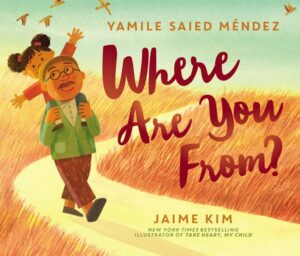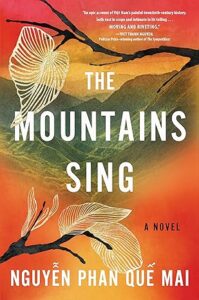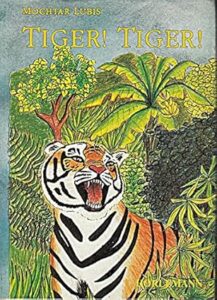In the previous blog post, I looked at the definition of Social-Emotional Learning (SEL) and its five components according to CASEL 5.
This blog post is about the first components: self-awareness and some examples of picture books that are published in this category.
What is Self-awareness?
According to CASEL 5, self-awareness defines as the ability to understand one’s own emotions, thoughts, and values and how they influence behavior across contexts. This includes capacities to recognize one’s strengths and limitations with a well-grounded sense of confidence and purpose. [Reference].
This short video gives a good introduction to this topic.
Which topics do belong to self-awareness?
Here are the topics that CASEL 5 introduced in the category of self-awareness:
- Identifying emotions
- Social and cultural identity
- Recognizing strengths
- Growth mindset
- Self-efficacy
- Examining bias
- Sense of purpose
Let’s review them one by one and look at some picture books in each category.
Identifying emotions
The first step in awareness is to identify that different emotions exist and teach the relevant vocabulary. Otherwise, a child (and an adult later) cannot express herself clearly. If you want to write a picture book with this theme, looking at the Emotion Wheel (image below) would be helpful. My website doesn’t let me upload a high-resolution image. Please download the image here.
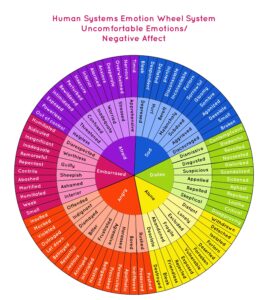
Crying is Like the Rain: A Story of Mindfulness and Feelings (2020) by Heather Hawk Feinberg and Chamisa Kellogg is a brilliant book about crying. It gives the children a new perspective on crying—such a brilliant book. I fell silent and all ears when I read this book the first time. I wish someone had written this book when I was 4.

A sentence of the book reads:
Another wonderful example is the series The way I feel books by Cornelia Maude Spelman is published about two decades ago. In each book, she introduced the feeling with very relatable examples. Next, she gives solutions of what to do when you feel so. This series is timeless, absolutely timeless. 

Speaking about anger seems to be an evergreen topic. See, for example, Angry Me (2022) by Sandra V. Feder and Rahele Jomepour Belle.

Story, or concept book, that is the question!
The examples given above are all concept books. I wrote a blog post before about concept books on cultural and social topics. In a nutshell, a concept book introduces the reader to a concept. For example, it explains what anger means, how you feel when you are angry, and what you can do with such feelings. Concept books don’t have a narrative structure and, therefore, aren’t stories.
In the contrast, identifying feelings can be the subject of stories. A story has a narrative structure (Beginning, Middle, End). I will analyze the story example below, so my meaning will be more clear.
Most of the picture book samples I found in this category are concept books.
The point is both concept books and stories can have an SEL theme. It is useful to know which type would you like to write.
Laxmi’s Mooch (2021) by Shelly Anand and Nabi H. Ali is the story of a girl, embarrassed because of the hair above her lips—called Mooch in Hindi. This is an example of a story with a Narrative Structure with an SEL theme. It has an Inciting Event: the main character learns about her Mooch. And this gives her a negative feeling. Here the story starts.
She shared her feeling with her parents and her mother helps her to overcome her negative feeling (Middle). In the End, the main character shows another girl with blond hair that she has also Mooch.
The story has a good positive-change character arc. The character starts the story with a negative feeling. She overcomes this and feels comfortable with her body.

Social and cultural identity
Most of the picture books published with a social and/or cultural identity theme are about the religions or cultures of minorities. This includes both concept books and stories.
On the Jewish culture, picture books are either about the Jewish fests (Hannuka and Rosh Hashanah) or about traditional Jewish food, for example, Latkes for Santa Claus (2020) by Janie Emaus and Bryan Langdo. 
On the Muslim culture, picture books are either about Ramadan or wearing a hijab. For example,
Deep in the Sahara (2018) by Kelly Cunnane and Hoda Hadadi is about a Muslim Mauritanian girl.
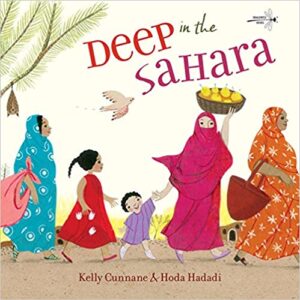
There are also some picture books about the cultures and traditions of minorities. For example, We Are Grateful: Otsaliheliga (2018) by Traci Sorell and Frane Lessac is about the culture and tradition of the Cherokee Nation.

It would be negligent to think all children are happy about their social and cultural identity, especially if they come from minatory groups, immigrants, or refugee families. A difference can (and does most of the time) cause unease! What a child should do with such feelings!?
There are not many books that tackle this issue. I am not saying these are easy topics. It is too damn difficult to speak and think about these feelings, let alone write stories about them. I tell this as an immigrant, not as a writer.
But, we have got to speak about these unpleasant feelings.
Where Are You From? (2019) by Yamile Saied Méndez and Jaime Kim is a brilliant book about a child of an immigrant family who is frequently asked where is from!
This spread of the book tells a world!
No, where are you really from? they insist.

The girl asks his Abuelo where she is from. And, he answers the most heartfelt sentences.
Another example is Your Name Is a Song (2020) by Jamilah Thompkins-Bigelow and Luisa Uribe. It is a story about a girl whose name is hard to pronounce.
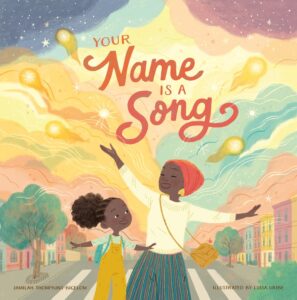
Nana Akua Goes To School (2020) by Tricia Elam Walker and April Harrison is another jewel.
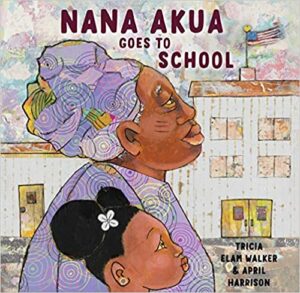
It is the story of a girl—Zura, who is upset and concerned to bring her grandmother to her school for the grandparent’s day. Her grandmother was born in Ghana and has marks on her face. Marks that her parents made on her face when she was a child. Zura feels unease
After this page, I read the book from behind a curtain of tears. My hat off to Tricia Elam Walker. She nailed it.
If you know of any other picture book similar to this, please kindly let me know in the comments.
Recognizing strengths
At first, it seemed to me that recognizing strengths and a growth mindset (the next item on this list) are the same thing. However, they have a subtle difference. Recognizing strength in a person means finding an aspect(s) that the person can do over and over while maintaining an excellent record. An aspect that the person can grow and expand in it and feel energized by doing it. A growth mindset has a different starting point. A person is not good at something but he will improve in it, even though it seems difficult.
\textsl{Nervous Nigel} (2022) by Bethany Christou is a very good example of this topic. Everyone in Nigel’s family is a champion swimmer and number-one medalist. Nigel loves swimming but relaxed swimming, not training for the competition. He is nervous and pretends that he, like other family members, loves competition. On the day of the competition, he even cannot jump into the river. He ran off with teary eyes and bumped into a frog. Frog asks him to give him a ride. On the other side of the river, the frog asks Nigel why he is upset. And, Nigel confesses his true feeling to the frog. Frog tells that riding on Nigel’s back was the best and most relaxed ride ever.

Nigel discovers his potential and establishes ‘Nigel’s Floating Ferry and Scenic Tours’.

Growth mindset
A growth mindset is when people believe that their most basic abilities can be developed through dedication and hard work.
Vashti, the main character of Dot (2004) by Peter H. Reynolds, believes she cannot draw. Her teacher encourages her to make a mark simply and she draws a dot. The story develops as Vashti gains confidence in her drawing ability.

The protagonist of Bella’s Recipe for Success (2021) by Ana Siqueira and Geraldine Rodríguez is a girl, with no confidence in herself. The story starts with her self-doubt. Her Abuela helps her to back. The story is a good example to learn about Character Arc.

It seems that children need a guide or mentor to overcome their feeling of inability. In some picture books that mentor is a human (a teacher or a family member). However, the mentor could appear in different forms and characters. Here are some creative examples:
In What the Road Said (2021) by Cleo Wade, the mentor is the road. Most of the book is a dialog between the worried boy and the road. Boy asks what-if questions; what if I get lonely, what if I fall, what if I go the wrong way, etc. And, the road answers.

Even more creative is A Walk in the Words (2021) by Hudson Talbott. This is the story of a boy, a very slow reader. While words frighten him, his curiosity saves him. Such a dear story.

There are many picture books published on growth mindset. Here is a list of more than forty titles!
Self-efficacy
I have to confess that I hadn’t heard of this term before writing this blog post!
Self-efficacy is the belief in your own ability to succeed in achieving a goal. Psychologist Albert Bandura introduced this term in 1977. Self-Efficacy theory has had considerable influence on research, education, and clinical practice. In the field of health psychology, for example, the construct of self-efficacy has been applied to behaviors as diverse as self-management of chronic disease, smoking cessation, alcohol use, eating, pain control, and exercise.
Self-efficacy and self-confidence are used interchangeably but they are not the same. Also, self-efficacy is not the same as goal setting.
My research to find picture books with self-efficacy themes was resultless.
Examining bias
I couldn’t think of any picture book about examining bias at the top of my head. By research, I found some blog posts that give lists of picture books under the title of anti-bias or bias. But, it seemed that there is a confusion between bias and prejudice.
The definition of bias in the dictionary is an inclination for or against a person, idea, or thing, especially in a way considered to be unfair. And prejudice is a preconceived opinion that is not based on actual experience or reason.
Bias is simply a preference. For example, if you ask me Windows or Mac and I answer without reasoning, that is bias. I preferred Windows without having a clear reason(s) in my conscious. Prejudice is when I judge a person without any evidence. For example, I don’t hire a person for a job only because she belongs to a specific group. Sentences like ‘black people are so and such’ or ‘Muslims are so and such’ are prejudiced, not biased.
Examining bias means teaching our children to think of reasons for their preferences and examine them. If you know any title on this theme, I would be grateful to know.
Sense of purpose
I couldn’t find a picture book for this topic and I am wondering if this topic suits young children. Sense of purpose is not the same as goal setting. CASEL 5 considers goal setting as a part of self-management.
Please, in the comments below, let me know if you know an example or if you have a different opinion.
The next blog post on the series of SEL is about picture books published on the second component of SEL; self-management.
I write blog posts about the craft of writing picture books regularly. The list of my previous blog posts is on the PictureBookPedia. Also, I publish a quarterly newsletter that includes links to my recent blog posts. The form you have selected does not exist.
